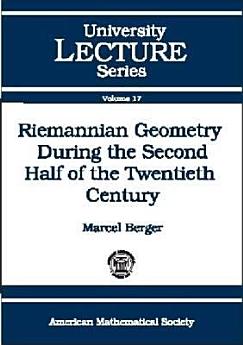Riemannian Geometry During the Second Half of the Twentieth Century
Jan 2000 · University Lecture Series Book 17 · American Mathematical Soc.
Ebook
182
Pages
reportRatings and reviews aren’t verified Learn More
About this ebook
During its first hundred years, Riemannian geometry enjoyed steady, but undistinguished growth as a field of mathematics. In the last fifty years of the twentieth century, however, it has exploded with activity. Berger marks the start of this period with Rauch's pioneering paper of 1951, which contains the first real pinching theorem and an amazing leap in the depth of the connection between geometry and topology. Since then, the field has become so rich that it is almost impossible for the uninitiated to find their way through it. Textbooks on the subject invariably must choose a particular approach, thus narrowing the path. In this book, Berger provides a remarkable survey of the main developments in Riemannian geometry in the second half of the last fifty years. One of the most powerful features of Riemannian manifolds is that they have invariants of (at least) three different kinds. There are the geometric invariants: topology, the metric, various notions of curvature, and relationships among these. There are analytic invariants: eigenvalues of the Laplacian, wave equations, Schrödinger equations. There are the invariants that come from Hamiltonian mechanics: geodesic flow, ergodic properties, periodic geodesics. Finally, there are important results relating different types of invariants. To keep the size of this survey manageable, Berger focuses on five areas of Riemannian geometry: Curvature and topology; the construction of and the classification of space forms; distinguished metrics, especially Einstein metrics; eigenvalues and eigenfunctions of the Laplacian; the study of periodic geodesics and the geodesic flow. Other topics are treated in less detail in a separate section. While Berger's survey is not intended for the complete beginner (one should already be familiar with notions of curvature and geodesics), he provides a detailed map to the major developments of Riemannian geometry from 1950 to 1999. Important threads are highlighted, with brief descriptions of the results that make up that thread. This supremely scholarly account is remarkable for its careful citations and voluminous bibliography. If you wish to learn about the results that have defined Riemannian geometry in the last half century, start with this book.
Rate this ebook
Tell us what you think.
Reading information
Smartphones and tablets
Install the Google Play Books app for Android and iPad/iPhone. It syncs automatically with your account and allows you to read online or offline wherever you are.
Laptops and computers
You can listen to audiobooks purchased on Google Play using your computer's web browser.
eReaders and other devices
To read on e-ink devices like Kobo eReaders, you'll need to download a file and transfer it to your device. Follow the detailed Help Center instructions to transfer the files to supported eReaders.









